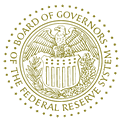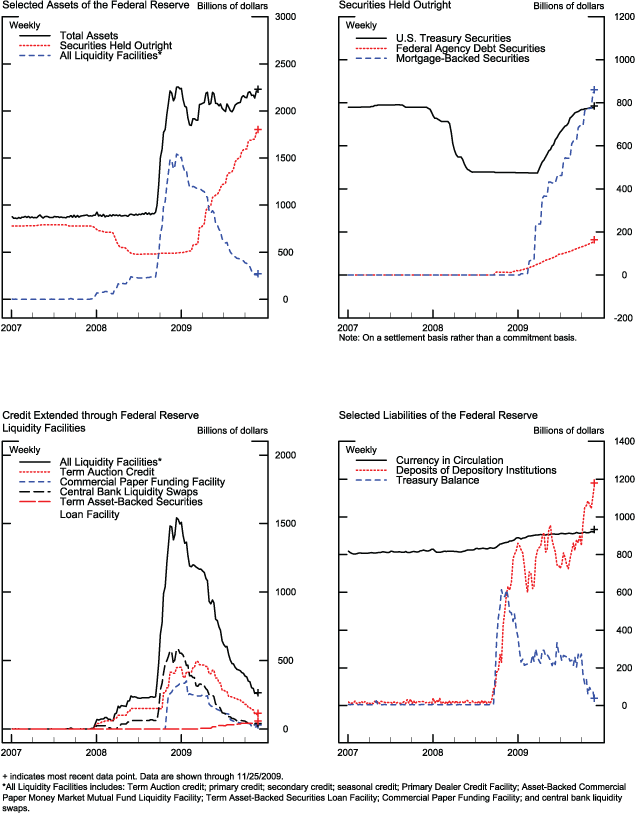Home
> Monetary Policy
> Quarterly Report on Federal Reserve Balance Sheet Developments
> Monthly Report on Credit and Liquidity Programs, 2009
> CLBS Report, December 2009


Monthly Report on Credit and Liquidity Programs
and the Balance Sheet
December 2009 (1.16 MB PDF)
| Purpose | Overview | SOMA and Liquidity Swaps |
Overview
Recent Developments
- Continued improvements in financial market conditions have been accompanied by further declines in the amount of credit extended through many of the Federal Reserve's liquidity programs.
- On December 16, 2009, the Federal Open Market Committee (FOMC) and the Board of Governors announced that they anticipate that most of the Federal Reserve's special liquidity facilities will expire on February 1, 2010, consistent with the Federal Reserve's announcement of June 25, 2009. These facilities include the Asset-Backed Commercial Paper Money Market Mutual Fund Liquidity Facility (AMLF), the Commercial Paper Funding Facility (CPFF), the Primary Dealer Credit Facility (PDCF), and the Term Securities Lending Facility (TSLF). The Federal Reserve will also be working with its central bank counterparties to close its temporary liquidity swap arrangements by February 1. The Federal Reserve expects that amounts provided under the Term Auction Facility (TAF) will continue to be scaled back in early 2010. The anticipated expiration dates for the Term Asset-Backed Securities Loan Facility (TALF) remain set at June 30, 2010, for loans backed by new-issue commercial mortgage-backed securities (CMBS) and March 31, 2010, for loans backed by all other types of collateral.
- The November 2009 TALF subscription of CMBS supported the primary issuance of the first CMBS deal brought to the market since June 2008. Of the $323 million of AAA-rated debt issued, $72 million was financed through the TALF.
- On December 4, 2009, the Federal Reserve Board adopted a final rule establishing a process by which the Federal Reserve Bank of New York (FRBNY) may determine which credit rating agencies are eligible to issue ratings on asset-backed securities--other than those backed by commercial real estate--to be accepted as collateral for the TALF.
- On December 1, 2009, the FRBNY received preferred interests in two special purpose vehicles (SPVs) established by American International Group, Inc. (AIG), completing transactions announced in March 2009. The SPVs were created to hold all the equity of the company's largest foreign insurance subsidiaries, American International Assurance Company Ltd. (AIA) and American Life Insurance Company (ALICO). In exchange for the preferred interests, the balance and amount of credit available to AIG under the FRBNY's revolving credit facility was reduced by $25 billion. These transactions advance AIG's global divestiture plan by preparing AIA and ALICO for initial public offerings or sale, and reduce the company's financial leverage.
- In December 2009, the FRBNY conducted a set of small-scale, real-value, triparty reverse repurchase transactions with primary dealers. Reverse repurchase agreements are a tool that could be used to support a reduction in monetary accommodation at the appropriate time. These transactions were conducted to ensure operational readiness at the Federal Reserve, the major clearing banks, and the primary dealers, and had no material impact on the availability of reserves or on market rates.
- The FRBNY announced on November 18, 2009, that it would scale back its use of external investment managers and begin to use its own staff on select days to execute large-scale asset purchase (LSAP) program agency mortgage-backed security (MBS) purchases. This change was not related to performance: the FRBNY had anticipated that it would adjust its use of external investment managers as it gained more experience with the program.
- As required by Section 129 of the Emergency Economic Stabilization Act of 2008, the Federal Reserve must report to Congress on the status of its Section 13(3) credit facilities that have credit outstanding. The Federal Reserve provides this information monthly as part of this report.
Table 1. Assets, Liabilities, and Capital of the Federal Reserve System
Billions of dollars
| Item |
Current November 25, 2009 |
Change from October 28, 2009 |
Change from November 26, 2008 |
|---|---|---|---|
| Total assets | 2,210 | +45 | +102 |
| Selected assets | |||
| Securities held outright | 1,784 | +94 | +1,295 |
| U.S. Treasury securities1 | 777 | +2 | +301 |
| Federal agency debt securities1 | 155 | +13 | +143 |
| Mortgage-backed securities2 | 852 | +78 | +852 |
| Memo: Term Securities Lending Facility3 | 0 | 0 | -193 |
| Memo: Overnight securities lending3 | 7 | +1 | -1 |
|
Memo: Net commitments to purchase mortgage-backed securities4 |
146 | -23 | +146 |
| Lending to depository and other financial institutions | 121 | -41 | -489 |
| Primary, secondary, and seasonal credit | 20 | -3 | -72 |
| Term auction credit | 101 | -38 | -306 |
| Primary dealer and other broker-dealer credit | 0 | 0 | -58 |
|
Asset-Backed Commercial Paper Money Market Mutual Fund Liquidity Facility |
0 | 0 | -53 |
| Central bank liquidity swaps5 | 26 | -7 | -449 |
| Lending through other credit facilities | 60 | -1 | -235 |
|
Net portfolio holdings of Commercial Paper Funding Facility LLC6 |
15 | -4 | -279 |
| Term Asset-Backed Securities Loan Facility, net | 45 | +3 | +45 |
| Support for specific institutions | 110 | -* | +6 |
|
Credit extended to American International Group, Inc., net7 |
45 | +* | -11 |
|
Net portfolio holdings of Maiden Lane Maiden Lane II, and Maiden Lane III LLCs8 |
65 | -* | +17 |
| Net portfolio holdings of TALF LLC9 | * | +* | +* |
| Total liabilities | 2,157 | +45 | +92 |
| Selected liabilities | |||
| Federal Reserve notes in circulation | 883 | +8 | +48 |
| Deposits of depository institutions | 1,169 | +85 | +558 |
| U.S. Treasury, general account | 13 | -18 | -4 |
| U.S. Treasury, supplementary financing account | 15 | -15 | -464 |
| Other deposits | 2 | -9 | -7 |
| Total capital | 53 | +* | +10 |
Note: Unaudited. Components may not sum to totals because of rounding.
* Less than $500 million. Return to table
1. Face value. Return to table
2. Guaranteed by Fannie Mae, Freddie Mac, and Ginnie Mae. Current face value, which is the remaining principal balance of the underlying mortgages. Does not include unsettled transactions. Return to table
3. Securities loans under the Term Securities Lending Facility and the overnight facility are off-balance-sheet transactions. These loans are shown here as a memo item to indicate the portion of securities held outright that have been lent through these programs. Return to table
4. Current face value. These generally settle within 180 days and include commitments associated with outright transactions as well as dollar rolls. Return to table
5. Dollar value of the foreign currency held under these agreements valued at the exchange rate to be used when the foreign currency is returned to the foreign central bank. Return to table
6. Includes commercial paper holdings, net, and about $5 billion in other investments. Return to table
7. Excludes credit extended to Maiden Lane II and III LLCs. Return to table
8. Fair value, reflecting values as of September 30, 2009. Fair value reflects an estimate of the price that would be received upon selling an asset if the transaction were to be conducted in an orderly market on the measurement date. Fair values are updated quarterly. Return to table
9. As of November 25, 2009, TALF LLC had purchased no assets from the FRBNY. Return to table
* Less than $500 million. Return to table
1. Face value. Return to table
2. Guaranteed by Fannie Mae, Freddie Mac, and Ginnie Mae. Current face value, which is the remaining principal balance of the underlying mortgages. Does not include unsettled transactions. Return to table
3. Securities loans under the Term Securities Lending Facility and the overnight facility are off-balance-sheet transactions. These loans are shown here as a memo item to indicate the portion of securities held outright that have been lent through these programs. Return to table
4. Current face value. These generally settle within 180 days and include commitments associated with outright transactions as well as dollar rolls. Return to table
5. Dollar value of the foreign currency held under these agreements valued at the exchange rate to be used when the foreign currency is returned to the foreign central bank. Return to table
6. Includes commercial paper holdings, net, and about $5 billion in other investments. Return to table
7. Excludes credit extended to Maiden Lane II and III LLCs. Return to table
8. Fair value, reflecting values as of September 30, 2009. Fair value reflects an estimate of the price that would be received upon selling an asset if the transaction were to be conducted in an orderly market on the measurement date. Fair values are updated quarterly. Return to table
9. As of November 25, 2009, TALF LLC had purchased no assets from the FRBNY. Return to table
Figure 1. Credit and Liquidity Programs and the Federal Reserve's Balance Sheet

Last update:
August 2, 2013


